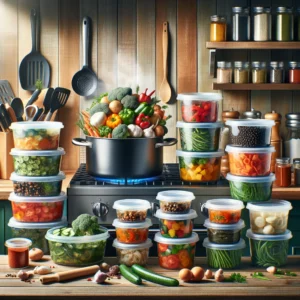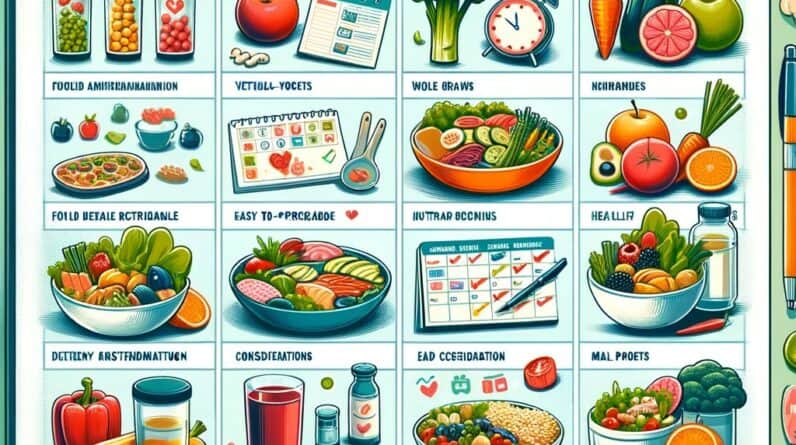
Dementia Discovery That is Leaving Doctors Speechless (Try This Tonight)
Better than Morphine For Joint Pain… Yet Safer Than Aspirin?
Retire With Freedom. Start Earning Extra Cash Today.
Introduction
Cooking healthy meals on a budget is not only possible, but it can also be incredibly rewarding.
In this article, we’ll explore ten practical tips to help you prepare nutritious and delicious meals without breaking the bank.
Whether you’re a seasoned home cook or just starting your culinary journey, these tips will empower you to make smart choices and elevate your cooking experience.

Tip 1: Plan Your Meals in Advance
Why Meal Planning is Important
Meal planning is essential for efficient budget-friendly cooking. It goes beyond just deciding what to eat; it’s a strategy that involves coordinating meals, recipes, and ingredients.
Let’s dive into the detailed reasons why meal planning is a game-changer:
- Cost-Efficiency: When you plan your meals, you can shop strategically to make the most of sales and bulk purchases. This saves money and prevents last-minute splurges on expensive convenience foods.
- Reduces Food Waste: By planning your meals, you can buy only the necessary ingredients, thus minimizing the chances of leftover perishables going to waste.
- Healthy Choices: Planning allows you to focus on balanced, nutritious meals. You can incorporate a variety of seasonal fruits, vegetables, and whole grains into your meal plan for a well-rounded diet.
- Time-Saver: A solid meal plan saves time by streamlining the shopping process and eliminating daily decisions about what to prepare and eat. This is especially beneficial for busy individuals.
Creating a Weekly Meal Plan
When it comes to creating a weekly meal plan, there are several key factors to consider to make the process effective and sustainable.
By taking into account your schedule, dietary preferences, and the ingredients you already have on hand, you can streamline the meal planning process and set yourself up for success.
Here are some important points to keep in mind when crafting a weekly meal plan:
- Schedule: Assess your weekly schedule to determine the best times for meal preparation and consumption. Consider busier days when quick and easy recipes are essential, and allocate more time for meal prepping on quieter days.
- Dietary Preferences: Take your dietary preferences and restrictions into account. Whether you follow a specific diet or simply prefer certain types of cuisine, tailor your meal plan to align with your culinary preferences.
- Ingredient Inventory: Before planning your meals, take stock of the ingredients you already have in your pantry, fridge, and freezer. This will not only help minimize food waste but also guide your recipe selection based on the items you already have on hand.
Optimizing your meal planning process involves utilizing various strategies to ensure efficiency and practicality. Consider the following approaches when creating your weekly meal plan:
- Batch Cooking: Save time and effort by preparing multiple servings of a dish at once. This allows you to enjoy leftovers for future meals and reduces the need for daily cooking.
- Meal Diversity: Incorporate a variety of cuisines and flavors into your meal plan to keep your palate engaged and prevent culinary monotony.
- Seasonal Ingredients: Embrace seasonal produce when planning your meals to take advantage of fresh, flavorful, and cost-effective ingredients.
By incorporating these considerations and strategies into your weekly meal plan, you can not only streamline the meal preparation process but also enjoy a diverse and satisfying array of meals throughout the week.
Tip 2: Shop with a List
Benefits of Shopping with a List
Shopping with a list offers numerous benefits that go beyond simple organization. By implementing a detailed shopping list, you can:
- Maintain an Organized Approach: A list helps you stay focused and organized while navigating the aisles of the supermarket. It prevents you from wandering aimlessly and wasting time trying to remember what you need.
- Avoid Impulse Purchases: With a list in hand, you are less likely to succumb to impulse purchases induced by clever marketing tactics or attractive packaging. This helps you stick to your budget and prioritize essential items.
- Remember Key Ingredients: For meal preppers and home cooks, a comprehensive list ensures that you never forget important ingredients for your planned meals. This saves you from the frustration of having to rush back to the store for forgotten items.
- Support Mindful Shopping: Shopping with a purposeful list encourages a mindful approach to grocery shopping. It allows you to concentrate on selecting nutritious, budget-friendly items rather than being swayed by gimmicky promotions.
- Reduce Food Waste: A well-planned list assists in purchasing only what is necessary, reducing the likelihood of buying excess perishable items that may go to waste. This contributes to a more sustainable and cost-effective shopping experience.
How to Create a Budget-Friendly Shopping List
Creating a budget-friendly shopping list is a strategic way to save money and make thoughtful choices about the food you purchase.
By following these tips, you can ensure that your grocery trips are cost-effective and tailored to your specific needs and preferences.
Start by carefully reviewing your planned meals for the upcoming week or month, depending on how often you shop.
Note down the specific quantities of each ingredient you require for your meals. This detailed approach will help prevent overbuying and reduce waste, ultimately saving you money.
When creating your shopping list, prioritize purchasing versatile ingredients that can be used across multiple recipes.
This includes items such as whole grains, legumes, and spices that can add depth and flavor to a variety of dishes.
By incorporating these versatile staples into your meals, you can minimize the need for specialized, single-use ingredients, which tend to be more expensive.
Take the time to compare prices at different grocery stores or online retailers.
While it may require a bit of extra effort, making informed decisions about where to purchase your groceries can lead to significant savings over time.
Look for opportunities to take advantage of sales, discounts, and bulk purchasing options to maximize your budget.
Another key strategy for creating a budget-friendly shopping list is to embrace seasonal produce and unprocessed foods.
Seasonal fruits and vegetables are often more affordable and abundant, providing an opportunity to enjoy fresh, nutritious ingredients at a lower cost.
Similarly, opting for unprocessed foods over packaged or pre-prepared items can lead to savings while promoting a healthier diet.
Tip 3: Buy in Bulk
Advantages of Buying in Bulk
Buying in bulk can lead to significant cost savings, especially for pantry staples and non-perishable items.
It allows you to take advantage of bulk discounts and reduces the frequency of shopping trips, saving both time and money in the long run. However, it’s essential to assess your storage space and consumption needs to avoid waste.
- Cost Savings: Buying in bulk enables you to benefit from lower prices due to the larger quantity, resulting in significant cost savings, especially for pantry staples and non-perishable items.
- Convenience and Efficiency: By purchasing in bulk, you reduce the frequency of shopping trips, saving both time and money in the long run. This also ensures that you always have essential items on hand.
- Reduction of Packaging Waste: Buying in bulk reduces the amount of packaging waste generated as compared to buying individual or smaller-sized items.
- Environmental Impact: Purchasing in bulk can contribute to a reduced carbon footprint and environmental impact, as it decreases the demand for packaging materials and transportation.
- Storage Considerations: It’s important to consider your storage space and consumption needs when buying in bulk. Proper storage solutions such as air-tight containers can help preserve the quality and freshness of bulk items.
Best Foods to Buy in Bulk
When considering bulk purchases, it’s essential to choose items that offer long shelf life, economic benefits, and versatile usage. Here are some top foods to buy in bulk:
- Whole Grains: Stock up on whole grains like rice, quinoa, and oats. These pantry staples are nutritious, and filling, and can be used in various dishes, from breakfast to dinner.
- Legumes: Dried beans, lentils, and chickpeas are excellent sources of protein, fiber, and essential nutrients. They’re incredibly versatile and can be incorporated into soups, stews, salads, and more.
- Nuts and Seeds: Consider buying bulk quantities of nuts (almonds, walnuts, etc.) and seeds (chia, flax, etc.) to add texture, flavor, and nutrition to your meals and snacks. They’re perfect for homemade granola, and trail mix, and as toppings for yogurt and salads.
- Olive Oil: A staple in many cuisines, olive oil is a heart-healthy fat that can be used for cooking, dressings, and marinades. Buying in bulk ensures that you always have this essential ingredient on hand.
- Canned Tomatoes: Versatile and convenient, canned tomatoes are a pantry essential. Use them in sauces, soups, stews, and as a base for countless recipes.
- Spices: Stock up on a variety of spices to add depth and flavor to your dishes. Consider popular options like cumin, cinnamon, paprika, and turmeric, as well as custom blends for specific cuisines.
Tip 4: Choose Affordable Ingredients
Identifying Affordable and Nutritious Ingredients
When it comes to budget-friendly cooking, identifying affordable yet nutritious ingredients is essential.
By making smart choices in the grocery store, you can prepare delicious and healthy meals without breaking the bank.
Here are some practical tips to help you identify affordable and nutritious ingredients:
- Seasonal Fruits and Vegetables: Take advantage of seasonal produce, which is not only fresher and tastier but also tends to be more affordable. Incorporate a variety of colorful fruits and vegetables into your meals to ensure a diverse range of nutrients.
- Whole Grains: Opt for whole grains like brown rice, quinoa, and oats. These options provide essential nutrients and fiber, making them a nutritious and budget-friendly choice for your meals.
- Legumes: Beans, lentils, and chickpeas are excellent sources of protein and fiber. They are also incredibly affordable, making them a great addition to your budget-friendly recipes.
- Lean Proteins: Look for cost-effective options such as skinless chicken breast, turkey, and fish. These lean proteins are not only nutritious but also versatile, allowing you to create a variety of delicious dishes.
Additionally, pay attention to sales and discounts offered by local grocery stores to maximize your savings.
Planning your meals around discounted items can significantly impact your overall food expenses while still maintaining a nutritious diet.
With these strategies, you can navigate the grocery store with confidence, knowing that you are making affordable and healthy choices for yourself and your family.
Substituting Expensive Ingredients
When a recipe calls for expensive or specialty ingredients, it’s helpful to explore suitable substitutions to align with your budget.
Making ingredient substitutions can not only save money but also add a unique twist to your dishes. Here are some practical and cost-effective ingredient swaps that can elevate your meals:
- Greek Yogurt for Sour Cream: Greek yogurt is a versatile and healthier alternative to sour cream. Its tangy flavor and creamy texture make it an excellent substitute in dips, dressings, and baked goods.
- Inexpensive Cuts of Meat: Instead of using pricier cuts of meat, consider utilizing more affordable options such as chuck, brisket, or shoulder. These cuts may require longer cooking times, but when prepared properly, they can deliver succulent and flavorful results.
- Vegetable Broth for Chicken or Beef Broth: Vegetable broth can be used as a substitute for chicken or beef broth in vegetarian or vegan dishes. It adds depth of flavor and richness while keeping the dish animal product-free.
Remember, it’s all about being resourceful and adaptable in the kitchen. Experimenting with ingredient substitutions can lead to delightful culinary discoveries while staying within your budget.
Tip 5: Cook in Batches

Benefits of Cooking in Batches
Cooking in batches offers numerous advantages that go beyond just time-saving and cost-effectiveness.
- Efficiency: When cooking in batches, you can streamline the entire meal preparation process, from ingredient organization to cleanup, saving valuable time and effort.
- Variety: Batch cooking allows for a wider variety of meals throughout the week, as you can prepare diverse dishes in one go, catering to different tastes and dietary preferences.
- Nutritional Balance: By planning and portioning meals in advance, you have the opportunity to create balanced, nutritious meals that meet your dietary goals, leading to healthier eating habits.
- Convenience: Having pre-cooked meals ready to heat and eat reduces the stress of daily meal preparation and makes it easier to stick to your dietary plan, especially during busy days.
Additionally, batch cooking encourages smarter grocery shopping, reduced food waste, and the development of culinary skills and creativity.
Batch Cooking Recipes
Batch cooking simplifies meal preparation and can save you time and effort in the kitchen.
It involves preparing larger quantities of food at one time, which can be stored and enjoyed throughout the week.
When choosing batch-cooking recipes, it’s important to select dishes that retain their flavor and texture when reheated.
Here are some key points to consider when selecting recipes for batch cooking:
- Versatile Ingredients: Look for recipes that incorporate versatile ingredients such as beans, lentils, and root vegetables. These ingredients hold up well when cooked in large batches and can be used in a variety of dishes.
- Adaptable Dishes: Focus on dishes that can be easily adapted for different meals. For example, a batch of roasted vegetables can be enjoyed on its own, served as a side dish, or used as a topping for salads and grain bowls.
- Efficient Cooking Methods: Consider utilizing slow cookers, pressure cookers, and sheet pans to streamline the batch cooking process. These cooking methods are ideal for preparing large quantities of food with minimal hands-on time.
Tip 6: Use Leftovers Wisely
Creative Ways to Use Leftovers
Leftovers offer a world of opportunities to create new and exciting meals, reducing food waste and optimizing your grocery budget.
Transform yesterday’s roasted vegetables into a flavorful frittata or repurpose excess grains and proteins into nourishing grain bowls or wraps.
With a dash of creativity, leftovers can become the foundation for a whole new dining experience.
- Roasted Vegetable Frittata Recipe
- Nourishing Grain Bowl Ideas
- Exciting Wraps Using Leftover Grains and Proteins
Tips for Storing Leftovers Safely
Proper storage of leftovers is crucial for maintaining their safety and quality.
It’s not just about tossing them in any container and throwing them in the fridge; there is a science to it that ensures your leftovers remain delicious and safe to eat.
Choosing the right food storage containers is the first step to keeping your leftovers safe and tasty.
Opt for high-quality, airtight containers that are specifically designed for storing food. Look for containers that are durable, BPA-free, and suitable for both the fridge and freezer.
Labeling your food containers with the date is a simple yet effective way to keep track of their freshness.
This ensures that you know exactly when the leftovers were stored, allowing you to prioritize consuming them based on their remaining shelf life.
After a meal, be sure to refrigerate or freeze the leftovers promptly. Leaving cooked food at room temperature for too long can lead to bacterial growth and compromise the safety of the food.
For optimal safety, place the leftovers in the fridge or freezer within two hours of cooking.
It’s essential to be aware of the recommended storage times for different types of dishes. While some leftovers may remain safe to eat for several days, others may have a shorter shelf life.
By understanding the specific storage times for various foods, you can minimize the risk of foodborne illness.
Handle leftovers with care to enhance their shelf life and maintain their delicious flavor.
Proper storage and handling can prevent premature spoilage, ensuring that you can enjoy your leftovers without compromising on taste or safety.
Tip 7: Grow Your Produce
Benefits of Growing Your Produce
Embarking on a home gardening journey can yield an array of benefits, including access to fresh, organic produce at minimal cost.
Growing your vegetables and herbs allows you to cultivate nutrient-rich ingredients right in your backyard or on your balcony, fostering a deeper connection to your food and the environment.
- Financial Savings: By growing your produce, you can significantly reduce your grocery expenses and save money on organic fruits and vegetables.
- Health Benefits: Consuming freshly harvested produce ensures that you are getting maximum nutritional value, as the ingredients are at their peak freshness and nutrient levels.
- Sustainability: Home gardening promotes sustainability by reducing the reliance on commercially grown produce, thereby decreasing environmental impact and carbon footprint.
- Education and Skill Development: It provides an opportunity for learning about plant life cycles, soil health, and the benefits of organic gardening practices, cultivating essential skills for self-sufficiency and environmental stewardship.
Easy-to-Grow Vegetables and Herbs
When starting your home garden, consider including a variety of easy-to-grow vegetables and herbs to enhance your produce selection.
These versatile and resilient plants not only thrive in a range of climates but also require minimal maintenance, making them ideal for novice gardeners.
By bringing the farm-to-table experience closer to home, you can savor the joy of harvesting your produce and experiencing the freshest flavors.
- Tomatoes: Whether you prefer cherry tomatoes, beefsteak tomatoes, or Roma tomatoes, these versatile fruits are a must-have in any home garden. Their ability to thrive in containers or garden beds makes them suitable for almost any gardening space.
- Peppers: From sweet bell peppers to spicy jalapenos, peppers are a colorful and flavorful addition to any home garden. With minimal care requirements, they are perfect for beginner gardeners.
- Lettuce: Enjoy a constant supply of fresh, crispy lettuce by growing varieties such as romaine, butterhead, and leaf lettuce. Their ability to thrive in partial shade makes them adaptable to different growing conditions.
- Basil: This aromatic herb is a staple in many cuisines and is easy to grow in a garden or even on a sunny windowsill. With a little pruning, you can have a continuous supply of fresh basil leaves.
- Mint: With its refreshing and invigorating flavor, mint is a delightful addition to any herb garden. It’s low-maintenance and can be grown in containers to control its spread.
Tip 8: Cook Seasonal Foods
Advantages of Cooking with Seasonal Foods
Seasonal foods offer numerous advantages, making them an ideal choice for culinary pursuits. Let’s explore the benefits of cooking with seasonal foods in more detail:
- Enhanced Flavor: Seasonal produce is at its peak ripeness, resulting in vibrant flavors that elevate the taste of your dishes.
- Nutritional Value: Fresh seasonal foods are packed with essential nutrients, providing a wholesome boost to your meals and supporting overall health.
- Economic Advantages: Enjoying seasonal foods often translates to cost-effective options, as they are in abundance and typically more affordable due to their availability.
- Supporting Local Agriculture: Embracing seasonal cooking allows you to contribute to local farming communities and sustainable food systems, fostering a sense of connection with the earth and its natural cycles.
- Environmental Impact: Choosing seasonal ingredients minimizes the carbon footprint of your meals by reducing the need for extensive transportation and preserving the integrity of local ecosystems.
Seasonal Recipes for Every Season
Seasonal cooking is a delightful way to savor the unique flavors, colors, and nutritional benefits of each season’s produce.
By paying homage to nature’s bounty, you can create a culinary journey that celebrates the ebb and flow of the year.
- Spring Salad with Fresh Greens: A vibrant mix of arugula, spinach, and tender lettuce tossed with seasonal herbs, radishes, and a light vinaigrette.
- Asparagus Risotto: Creamy, risotto goodness combined with delicate asparagus spears, bright lemon zest, and a sprinkle of Parmesan.
- Caprese Skewers: Fresh mozzarella, ripe cherry tomatoes, and fragrant basil leaves, drizzled with balsamic glaze and olive oil.
- Grilled Vegetable Platter: An assortment of seasonal vegetables lightly charred and seasoned to perfection.
- Butternut Squash Soup: A silky smooth blend of roasted butternut squash, aromatic spices, and a touch of cream.
- Apple & Sage Stuffed Pork Tenderloin: Tender pork filled with a savory mix of apples, sage, and breadcrumbs, roasted to perfection.
- Beef & Root Vegetable Stew: Hearty chunks of beef stewed with root vegetables, fragrant herbs, and a rich, savory broth.
- Winter Citrus Salad: A refreshing medley of citrus fruits, pomegranate seeds, and crunchy almonds, finished with a honey-poppy seed dressing.
By embracing seasonal recipes, you can embark on a culinary exploration that captures the essence of each season while enjoying the freshest and most flavorful ingredients available.
Tip 9: Limit Processed Foods
Understanding the Dangers of Processed Foods
Processed foods have become a staple in the modern diet, offering convenience but often at the cost of our health.
Here, we delve deeper into the specific dangers associated with processed foods, shedding light on the various health risks they pose.
- Excess Sodium:Many processed foods contain high amounts of sodium, which can lead to hypertension, heart disease, and kidney problems.
- Added Sugar: The excessive sugar in processed foods contributes to obesity, diabetes, and dental issues.
- Unhealthy Fats: Trans fats and saturated fats found in processed foods increase the risk of cardiovascular disease and stroke.
- Artificial Additives: Synthetic additives such as preservatives, colorings, and flavorings in processed foods have been linked to various health concerns, including allergies and hyperactivity in children.
By understanding these dangers, we can make informed decisions about our food choices and take steps to minimize the consumption of processed foods.
Healthy Alternatives to Processed Foods
When it comes to healthy alternatives to processed foods, several options can enhance the nutritional value of your meals. Here’s an in-depth look at some of the best alternatives:
- Whole Grains: Opt for whole grains such as quinoa, brown rice, oats, and barley. These alternatives are rich in fiber, vitamins, and minerals, providing sustained energy and promoting digestive health.
- Fresh Produce: Incorporate a variety of fresh fruits and vegetables into your diet. These nutrient-dense options offer a wide range of essential vitamins, antioxidants, and phytonutrients that support overall health and well-being.
- Lean Proteins: Choose lean protein sources like poultry, fish, tofu, beans, and legumes. These alternatives provide high-quality protein without the added preservatives and unhealthy fats often found in processed meats.
Additionally, consider making your condiments and sauces at home.
By creating homemade versions, you can control the ingredients, limit added sugars and preservatives, and customize the flavors to suit your preferences.
This simple switch not only enhances the taste of your meals but also reduces the intake of hidden unhealthy additives.
By being mindful of these healthy alternatives, you can elevate the nutritional profile of your meals, promote overall wellness, and maintain a budget-conscious approach to your dietary choices.
Tip 10: Be Mindful of Portion Sizes
Importance of Portion Control
Practicing portion control is pivotal for maintaining a balanced diet and optimizing your grocery budget.
By being mindful of portion sizes, you can prevent food waste and ensure that meals are appropriately sized to meet your nutritional needs.
This mindful approach fosters a healthy relationship with food while supporting your budgetary goals.
Tips for Portion Control
Implement practical tips for portion control, such as using smaller plates, measuring serving sizes, and avoiding second helpings.
Embrace the concept of mindful eating, savoring each bite, and being attuned to your body’s hunger and fullness cues.
By cultivating mindful portion practices, you can savor your meals and economize your food resources.
Conclusion
Empowering yourself with the knowledge and strategies to cook healthy meals on a budget opens the door to a world of culinary creativity and financial prudence.
By implementing the ten tips outlined in this article, you can embark on a flavorful and nutritious journey while effectively managing your household food budget.
Embrace the joys of mindful eating, resourceful cooking methods, and a deeper connection to the food you prepare.
Here’s to wholesome meals that nourish both body and soul, without putting a strain on your finances!






